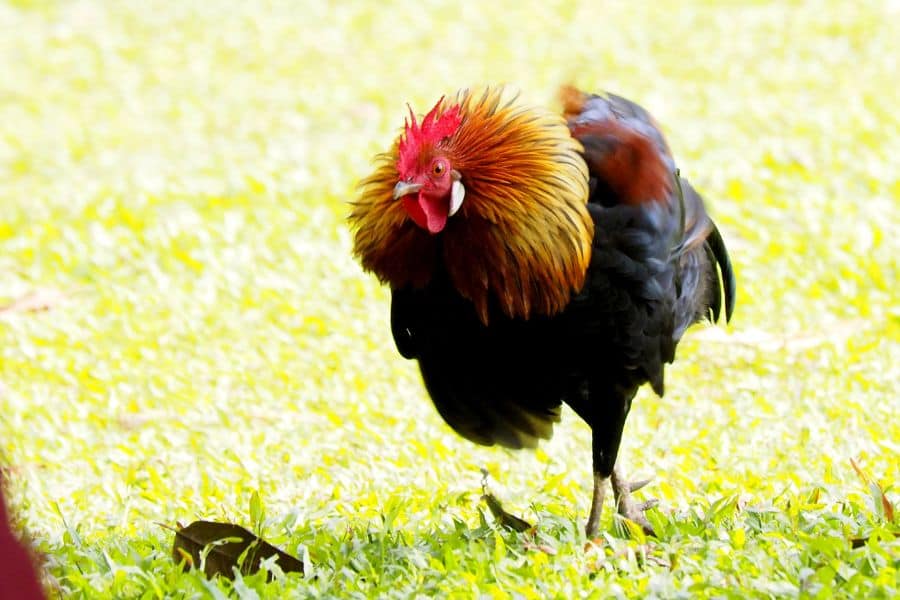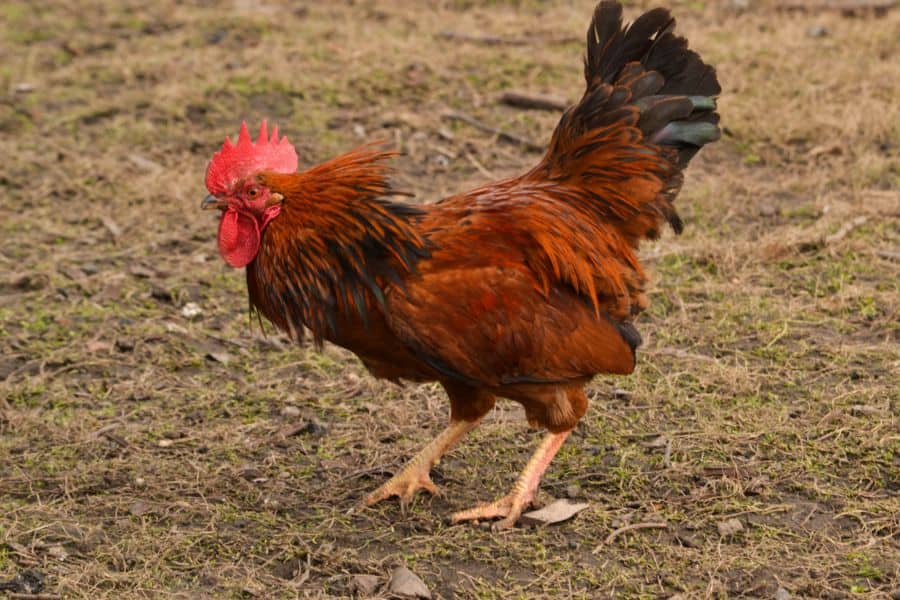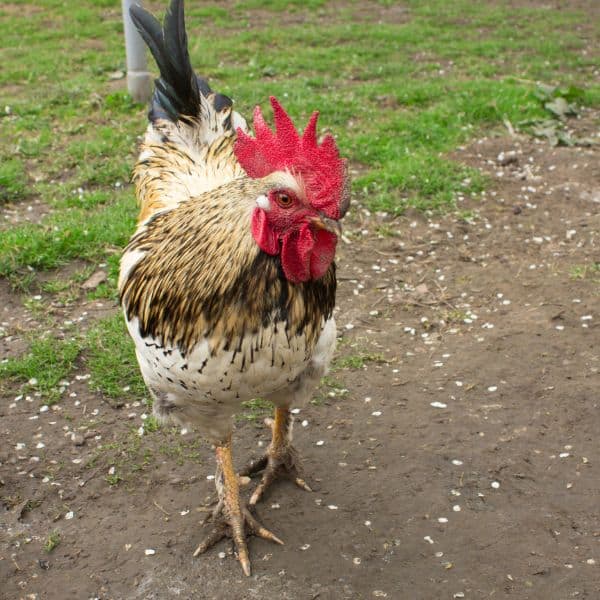Aggression is a common trait in the males of many species and roosters are no different. For many years, humans even took advantage of this and turned it into a sport, with some chickens being bred specifically to fight.
However, aggression is a problem for many backyard farmers. Overly aggressive chickens can harm or kill other chickens or even people, in some instances.
To deal with aggressive roosters, it’s important to understand what makes roosters aggressive in the first place. This can help you to train aggressive behaviors out of them.

However, before a rooster is trained or tamed, you may find yourself having to weather a few confrontations with them.
In this article, we look at how you can deal with aggressive roosters. We also discuss effective ways of responding during and after an attack from such roosters to dissuade this behavior in the future.
Why Are Roosters Aggressive?
Unlike what some may have you believe, roosters are not always looking for a fight. Aggression in roosters comes about because:
- Chickens are prey animals, and it is usually the rooster’s job to alert the rest of the flock when there’s danger or to take on the perceived threat himself.
- Chickens have a complex social order, and it is the rooster’s job to maintain order. This helps to reduce infighting in the flock and actually benefits the weaker members who would otherwise get constantly picked on.
As prey animals, chickens and especially roosters are constantly on the lookout for threats. Therefore, if your rooster gets aggressive around you, it’s probably because he perceives you as a threat.
Additionally, while you may think that your rooster attacks for no reason, certain behaviors that are normal to us may seem threatening to a rooster, e.g., swinging a bucket.
As to the complex social order of chickens, when you enter what the rooster considers his territory, he sees you as a threat to his dominance.
Why Do Roosters Attack Humans?
The first reason why a rooster may attack you is because they see you as a threat to the flock. In this case, they are simply playing the role you’d expect them to if a predator swooped in from above.
Secondly, as explained above, a rooster will attack an individual they consider a challenger to their dominant status in the flock. This may be another rooster, or it may be you walking around the coop.
Why Did a Previously Calm Rooster Become Aggressive?
Many chicken owners are perplexed when a previously calm rooster suddenly becomes aggressive. This is not unusual when it comes to developing roosters.
When a rooster approaches sexual maturity, there is a marked increase in sex hormones. These hormones not only prepare them for mating but for the social competition that will determine whether they get mating opportunities.
The hormone that is mainly associated with this increased level of aggression is testosterone. This hormone will cause:
- Higher levels of aggression
- Greater muscle growth
- Reduced deposition of fat
- Inhibition of molting
Secondary to this, backyard farmers may notice that their roosters are more aggressive during certain periods of the year. This is usually the chickens’ mating season.
During mating season, the competition for mating rights is at its peak. The roosters will be very focused on mating and this increased level of aggression can be a problem for people and even for the hens.
What Are the Names of Different Rooster Attacks?
Roosters have several methods that they can use to attack you or a rival rooster. These are:
- Spurring: This is where the rooster leaps up and rakes his target using his spurs. The spurs are sharp and can grow up to several inches long.
- Flogging: This is when roosters fly up and attempt to beat their targets using their wings.
- Chasing: As the name suggests, this is when the rooster aggressively charges after their target to get it to retreat.
- Pecking: Roosters can also peck their targets using their beaks.
How Dangerous are Rooster Attacks?
Many farmers get concerned when their roosters become aggressive and rightly so. Aggressive roosters can be a serious threat to other chickens and to people too.
Aggressive roosters may but not usually fight to the death with other roosters. The weaker rooster usually flees once they’ve been beaten.
However, long fights between chickens can result in serious injuries, some of which can be fatal.
Some rooster attacks have also resulted in human injuries and fatalities.
In one case, a woman contracted a rare type of tetanus after getting pecked in the face by a rooster. In another case, a man ended up dead due to blood loss after getting hit by a rooster’s spur in the back of his leg.
Signs a Rooster is About to Attack You
Fatal rooster attacks are rare but not out of the question. They can also cause some nasty injuries so it’s good to know the signs that one is about to go on the offensive.
Some of the signs you should look out for include:
- Lowering their head
- Spreading their wings wide
- Puffing up their hackles
- Dipping one shoulder in your direction while the other remains up while they stare at you.
- Stomping their feet.
- Doing a wing dance, i.e., shuffling around with one wing extended
These signs don’t always point to an impending attack. The wing dance, for example, is also part of their mating ritual.
Some roosters may also not show any obvious signs of aggression but will suddenly attack from behind.
Stopping a Rooster Before They Attack
Here are a few tips on how you can prevent an impending rooster attack once you see the signs:
- Distract him: Distracting your rooster with some snacks is quite effective at taking their minds off their planned attack. This shows them that you’re not a threat and are also a good source of treats.
- Move quickly and give them space. This will be good if you only need to be in the rooster’s space temporarily, but it is not a good long-term tactic.
- Avoid behavior that will incite or encourage the rooster. Moving aggressively and staring for too long may be seen as aggression, but creeping around the rooster may also be seen as weakness which can prompt further aggression.
- Don’t go for the hens because the rooster will consider it his duty to defend them.
- Stand your ground. Running away may encourage the rooster to chase after you.
If you know that your rooster tends to attack, it’s a good idea to dress for the occasion when going into the coop. You should dress in long-sleeved shirts and long pants to protect your skin in case you fail to stop the next attack.
What to Do When the Rooster Actually Attacks?
You may not be able to stop every potential attack by an aggressive rooster. Some individual roosters are determined so you must prepare yourself for the worst case.
Carry a Shield
As stated earlier, you should dress for the occasion when you enter the territory of an aggressive rooster. In addition to this, you should carry something you can use as a shield in case the rooster attacks.
A shovel or even a trash can lid should be sufficient for this task.
Keep Him at Bay but Don’t Attack
When a rooster attacks, your objective should be to keep him at bay but not to attack back. This means raising up your shield if they attempt to leap in your direction or simply sticking out a booted leg.
Hitting the rooster, squirting him, or even chasing him will only establish you more as a threat. This may encourage them to continue responding aggressively in the future.
Effective Methods of Dealing with Aggressive Roosters
When dealing with an aggressive rooster, the best outcome is not to simply stop their attack but to prevent their aggressive tendencies. You might be able to keep an aggressive rooster at bay, but it may still be a problem for children and others if it remains aggressive.
Two methods you can use are appeasement and establishing dominance.
Appeasement
Appeasing the rooster can convince him that you’re not a threat. To do this you’ll need to pick up the rooster, so it is best to wear heavy gloves.
Once you’ve caught the rooster, cradle him with one hand and stroke his wattles and throat gently. You can also speak to him in a calm and soothing voice.
Do this until the rooster relaxes. This can take a while so you can also sit or walk around with him.
Once the rooster is completely calm, set him down gently and watch how he behaves. If he calmly walks away then all is good, otherwise, you may have to repeat the process.
The process of appeasement takes time, and you may have to do this for a few days or weeks to convince the rooster you’re not a threat.
Establish Dominance
In some cases, the best way of dealing with an aggressive rooster is to let them know you’re in charge. One way of doing this is getting a hold of the rooster using gloved hands and securely, yet gently, pinning him to the ground for a period of time.
In the video below, the farmer recommends holding the chicken down with its beak toward the ground but not hurting the rooster in the process. This should be done for around half a minute.
You may have to repeat this process before an aggressive rooster finally gets the message. You may also need other people in your homestead to do the same thing, so the rooster knows not to challenge them either.
Should You Kill an Aggressive Rooster?
It’s not always possible to get aggressive roosters to change their ways. Even breeds that have a reputation for being docile will have individuals that are uncharacteristically aggressive.
Roosters with aggressive tendencies can be handled a few ways including:
- Rehoming them: Transferring a rooster to a different home can reduce their aggression. A rooster may be less aggressive if moved to a flock with a more assertive rooster at the top of the pecking order.
- Training them: As described above, roosters can be trained to make them less aggressive. In addition to the methods above, actions such as handling them from a young age may make them less aggressive once they mature.
Unfortunately, in some cases, farmers have stated that no amount of training has made their roosters less aggressive.
Rehoming roosters seems like a great idea especially if the rooster can be moved to a larger farm where his aggression can be useful when fighting off predators. However, rehoming is not always an option.
Other farmers may not have space or need for a rooster. An aggressive rooster may also become a threat to someone else if moved to a new home.
When there are limited options, many farmers opt to cull their aggressive roosters. This may seem cruel but keeping an aggressive rooster in your backyard farm may not be a realistic choice.
Read More:
Final Words
Roosters can be a great member of your backyard flock. They have beautiful colors on display and are useful in keeping the flock safe from threats.
Unfortunately, roosters can be a problem when they become aggressive. This happens when the roosters become sexually mature, but it’s more pronounced in certain breeds.
Aggressive roosters can attack in a number of ways including using their wings, beaks, and spurs. These attacks don’t usually cause a lot of damage, but some rooster attacks have had tragic consequences.
It’s important to know the signs that a rooster is about to attack. When you know the signs, you can either stop the rooster from attacking or defend yourself appropriately without harming the rooster.
Aggression can be reduced in roosters by appeasing them with treats or establishing dominance over them. However, when all else fails, you may have to take drastic measures such as rehoming the rooster or culling him.


